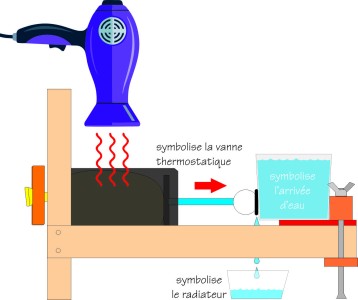 How to use - thermostatic radiator valve simulator
How to use - thermostatic radiator valve simulator
1. Place the balloon through the hole in the can and ensure that the nut inside magnetizes to the 'piston'.2. Inflate the balloon so that it takes up all the space in the can. Remove a small amount of air and close tightly with a plastic clip. Check that no air escapes.3. Place the can and its seal against the ball of the valve, and use the two bars to push it into a position where the O-ring creates a good seal. While maintaining pressure, tighten the two wing nuts.4. Place the cut cup under the wooden pearl to collect the water.5. Add water to the upper tray.6. By moving the two bars, find a position where the O-ring releases a drop of water approximately every second. Once this position has been found, tighten the two wing nuts.7. Push sligntly the drip tray to check that the flow stops quickly.8. Blow on the can with a hair dryer at its hottest position.9. The flow should drop or stop fairly quickly.10. After switching off the dryer, the flow will slowly return to its initial rate.


Warning: as the balloon is porous, after several attempts it might lose some of its air. To repeat the experiment, start from the beginning and re-inflate the balloon. Principle : The heat expands the air in the can and pushes the valve (ball) against the O-ring (seal), thus reducing or even stopping the flow of water.
The same principle is used in thermostatic radiator valve operators : depending on the room temperature, a gas expands or contracts to open or close the flow of hot water through the radiator.
 |  |  |  |  |  |  |


